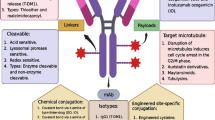Abstract
The monoclonal antibody, mAb 2C5, recognizing the surface of numerous tumor, but not normal, cells via their surface-bound nucelosomes, was coupled onto sterically protected poly(ethylene glycol) liposomes. In this study, the development of different mAb 2C5-targeted formulations, like radiolabeled liposomes for gamma imaging of tumors and doxorubicin-containing liposomes for cancer chemotherapy, is described. Our data demonstrate the enhanced in vitro anticancer activities and the evident tumor-avid in vivo biodistribution, confirming the superior tumor-selectivity of the mAb 2C5-modified liposomes. This report reveals the eminent potential for this tumor-targeting strategy, with mAb 2C5, in improving the delivery of drugs and imaging agents into various tumors.





Similar content being viewed by others
References
Torchilin VP. Recent advances with liposomes as pharmaceutical carriers. Nat Rev Drug Discov 2005;4(2):145–60
Allen TM, et al. Liposomes containing synthetic lipid derivatives of poly(ethylene glycol) show prolonged circulation half-lives in vivo. Biochim Biophys Acta 1991;1066(1):29–36
Klibanov AL, et al. Amphipathic polyethyleneglycols effectively prolong the circulation time of liposomes. FEBS Lett 1990;268(1):235–7
Maeda H, et al. Tumor vascular permeability and the EPR effect in macromolecular therapeutics: a review. J Control Release 2000;65(1–2):271–84
Gabizon A, et al. Clinical studies of liposome-encapsulated doxorubicin. Acta Oncol 1994;33(7):779–86
Torchilin VP. Liposomes as delivery agents for medical imaging. Mol Med Today 1996;2(6):242–9
Tilcock C, et al. Liposomal Gd-DTPA: preparation and characterization of relaxivity. Radiology 1989;171(1):77–80
Ahkong QF, Tilcock C. Attachment of 99mTc to lipid vesicles containing the lipophilic chelate dipalmitoylphosphatidylethanolamine-DTTA. Int J Rad Appl Instrum B 1992;19(8):831–40
Koukourakis MI, et al. Liposomal doxorubicin and conventionally fractionated radiotherapy in the treatment of locally advanced non-small-cell lung cancer and head and neck cancer. J Clin Oncol 1999;17(11):3512–21
Harrington KJ, et al. Phase II study of PEGylated liposomal doxorubicin (Caelyx) as induction chemotherapy for patients with squamous cell cancer of the head and neck. Eur J Cancer 2001;37(16):2015–22
Iakoubov LZ, Torchilin VP. A novel class of antitumor antibodies: nucleosome-restricted antinuclear autoantibodies (ANA) from healthy aged nonautoimmune mice. Oncol Res 1997;9(8):439–46
Iakoubov LZ, Torchilin VP. Nucleosome-releasing treatment makes surviving tumor cells better targets for nucleosome-specific anticancer antibodies. Cancer Detect Prev 1998;22(5):470–5
Chakilam AR, Pabba S, Mongayt D, Iakobouv LZ, Torchilin VP. A single monoclonal antinuclear autoantibody with nucleosome-restricted specificity inhibits the growth of diverse human tumors in nude mice. Cancer Therapy 2004;2(4):353–64
Lukyanov AN, et al. Tumor-targeted liposomes: doxorubicin-loaded long-circulating liposomes modified with anti-cancer antibody. J Control Release 2004;100(1):135–44
Torchilin VP, et al. p-Nitrophenylcarbonyl-PEG-PE-liposomes: fast and simple attachment of specific ligands, including monoclonal antibodies, to distal ends of PEG chains via p-nitrophenylcarbonyl groups. Biochim Biophys Acta 2001;1511(2):397–411
Torchilin VP, et al. TAT peptide on the surface of liposomes affords their efficient intracellular delivery even at low temperature and in the presence of metabolic inhibitors. Proc Natl Acad Sci U S A 2001;98(15):8786–91
Allen TM, et al. Use of the post-insertion method for the formation of ligand-coupled liposomes. Cell Mol Biol Lett 2002;7(3):889–94
Xiong XB, et al. Enhanced intracellular uptake of sterically stabilized liposomal Doxorubicin in vitro resulting in improved antitumor activity in vivo. Pharm Res 2005;22(6):933–9
Acknowledgments
This research was supported by the NIH grant R01-EB02995 to Vladimir P. Torchilin. We thank Dr. B.-A. Khaw of Northeastern University for his valuable help with the γ-scintigraphic imaging studies.
Author information
Authors and Affiliations
Corresponding author
Additional information
Surface attachment of the anticancer monoclonal antibody 2C5 to liposomes, on-top of their PEG shield, allows for enhanced targeted delivery of entrapped drugs or contrasts to a wide variety of tumors.
Rights and permissions
About this article
Cite this article
Elbayoumi, T.A., Torchilin, V.P. Tumor-Targeted Immuno-liposomes for Delivery of Chemotherapeutics and Diagnostics. J Pharm Innov 3, 51–58 (2008). https://doi.org/10.1007/s12247-008-9021-7
Published:
Issue Date:
DOI: https://doi.org/10.1007/s12247-008-9021-7




